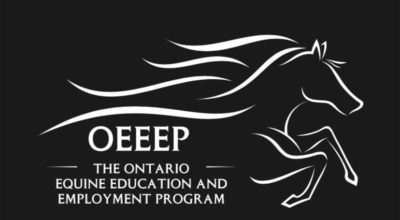Fire Prevention in the Barn
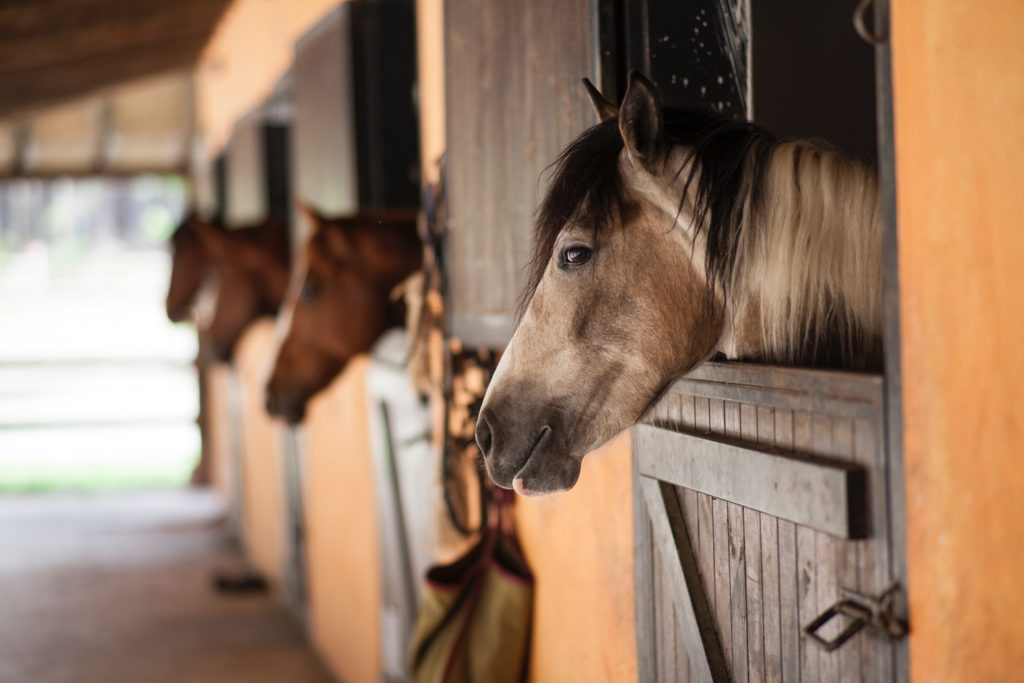
Learning Outcomes
By the end of this module, you will be able to:
- Identify the top causes/sources of barn fires
- Define the common myths and misconceptions about horses and barn fires
- Evaluate your barn/facility for potential fire risks
1. Introduction – The Risks of Barn Fires
Barn fires continue to be a challenge for the horse industry, causing incredible property damage – and, sadly, the loss of life for many horses each year.
Let’s look at a recent example, in June 2022, where a “devastating” fire destroyed a horse barn in Keene, Ontario. While the fire fighters were able to control the blaze and prevent its spread to other buildings on the property, the barn itself was declared to be a “total loss.”
How did this fire get started?
“A subsequent investigation determined the fire was caused by spontaneous combustion: hay on the property caught fire, he said. [Local fire chief Chuck] Parsons is reminding residents to ensure hay is kept dry — not damp — and encourages farmers to always have fire extinguishers at the ready near their barns.”
As we can see from the Fire Chief’s remarks, this was a preventable situation. Today, we will be taking a look at the top sources of Barn Fires – and, most importantly, what you can to do help prevent fires from starting in the first place.
1.1 Top Sources of Barn Fires
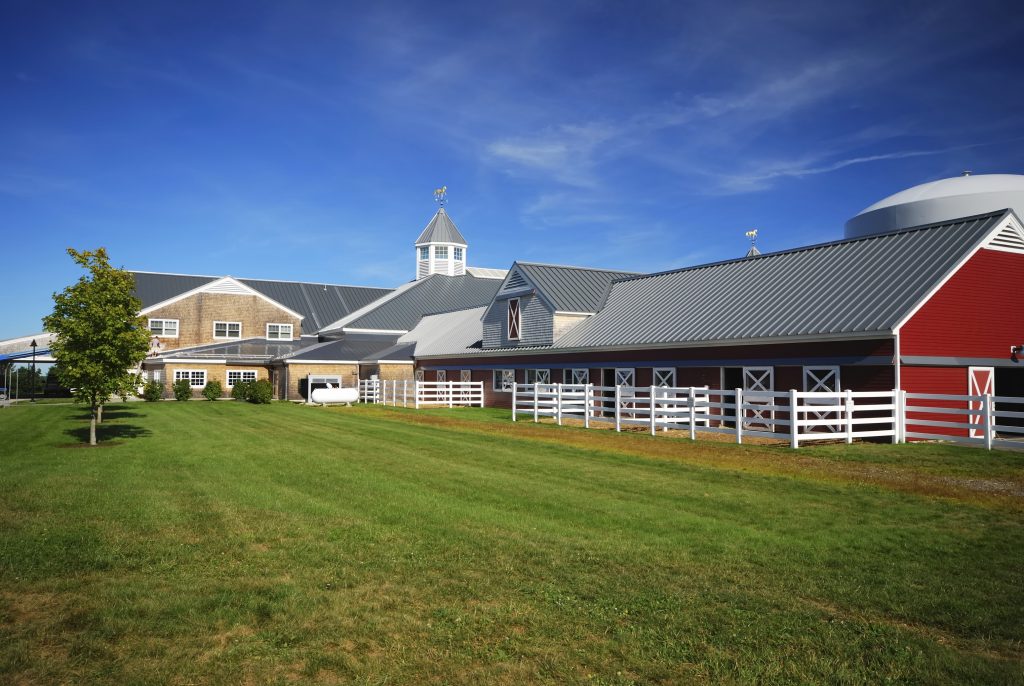
From the OMAFRA webpage, we can see that the primary cause of barn fires in Ontario is faulty electrical systems for the barn’s lighting, heating/cooling, etc. This can occur if the electrical system is outdated, or improperly installed.
A secondary cause, which relates to electrical systems, is faulty or misused electrical appliances. This can include old/aging equipment, the use of equipment for purposes other than what it was designed to do, and the over-reliance upon use of extension cords in the barn.
Safety tip: Extension cords should only be a temporary power solution! Long-term power solutions should be part of your overall electrical system, and installed by a professional.
The third major cause, as seen in the Keene fire above, is the improper storage of flammable/combustible materials in the barn, such as fuel, chemicals, or hay. This also relates to general lack of housekeeping, which can lead to buildup of flammable materials (dust, cobwebs, dry weeds/grasses, etc.)
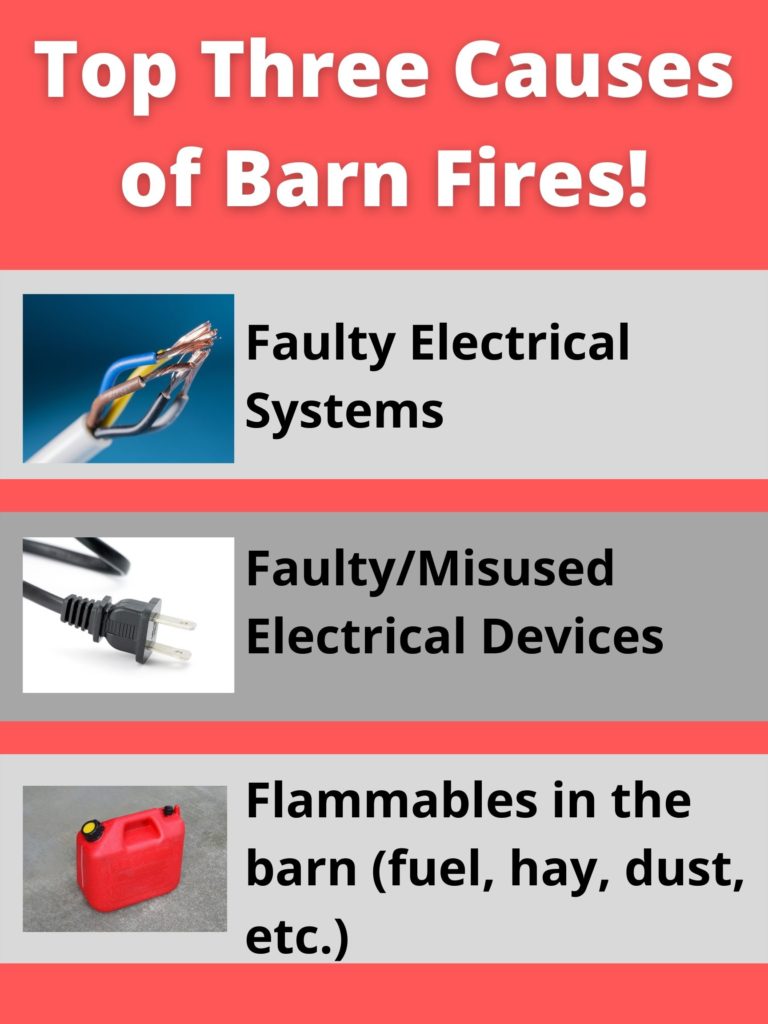
Fire Fighter Troy Moffatt (South Oxford, Ontario) explains further in this video, courtesy of Equine Guelph:
Troy has indicated a number of practices and things to look out for as you review your own barn/facility. Keep these in mind for today’s activity!
1.2 Barn Fire Myths
There are many myths and misconceptions about how horses will behave during an emergency situation, and what owners/caregivers should do to help rescue their horses. Recognizing these common myths will help barn/facility owners and staff with making informed decisions about how to respond if a fire occurs.
Let’s bust some of those myths!
Watch this short video from Dr. Rebecca Husted (3 mins) on the biggest myths about fires in horse barns. Dr. Husted is a volunteer firefighter from Georgia, USA, and is an internationally-recognized expert in Technical Large Animal Emergency Rescue Techniques.
Next, Dr. Husted explains about why horses might run back into a burning barn (5 mins):
Dr. Husted summarizes these points, and explains additional myths about barn fires in this article from the Best Horse Practices Summit.
Safety Tip! – The more you can learn about how your horses behave in an emergency, the better you can ensure their safety, and help first responders when they arrive!
Learning Activity – Quiz!
Check your understanding of the top causes of barn fires, as well as common misconceptions and myths, in this short quiz. You are required to complete this quiz to finish today’s module; however, your score will not be counted towards a final grade. You may retake the quiz as many times as you wish. Good luck!
<Fire Prevention in the Barn – Quiz>
2. Barn Facility Inspection
Learning Activity – ThingLink: Inside the Barn
Before heading off to your own barn/facility, take a few minutes to explore this interactive activity, which showcases some of the potential sources for barn fires, problem areas, and other practices to keep in mind.
What’s wrong with this picture?
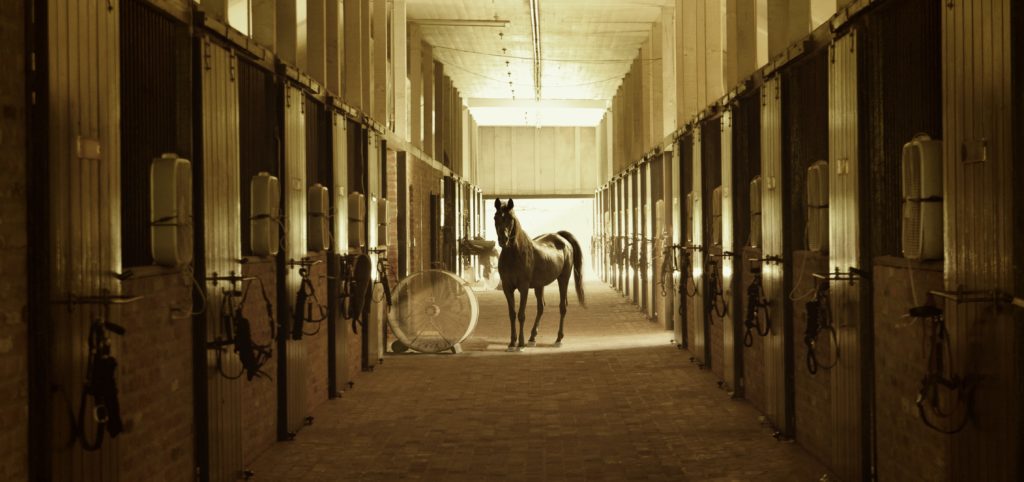
Learning Activity – Inspection of your Barn
Now it’s time to head outside and check out your own barn/facility (or one you have access to)! Take a few minutes and go through the barn, taking note of any potential sources for barn fires, or other areas of concern.
<Include video of instructor going through a barn/check, which will model the activity to the students – 5-10 mins>
You may find this Fire Prevention Checklist from Equine Guelph helpful as you go through.
Checklist (pdf)
Refer back to Troy Moffatt’s video from earlier in the module for other things to watch out for.
Don’t have a barn/facility that you can review? Please reach out to your instructor <indicate instructor email> for an alternative assignment. <this could be photos from inside an example of a barn, or other facility, or a video walkthrough>
Class Discussion
After completing your barn/facility overview, what did you notice? Any changes that you could make today? What barn fire prevention strategies were already in place?
Share your observations in the Discussion Forum! <link to course discussion page> You may also post a short video of your barn if you wish, or include photographs of any areas of concern / things you’re already doing well! (If you are not the owner/manager of the facility you are exploring, please seek permission first before posting any videos or photos. Please refrain from including any personal details about your farm/staff members in your post!
If you wish to submit your observations privately, please enter them in the form below for your instructor to review and provide feedback. You may also submit a video or audio recording via email!
3. Summary
In this module, we discussed the three primary causes of fires in horse barns – electrical systems, appliances, and storage/buildup of flammables in the barn. These are all causes that we as owners/staff/caregivers can take steps to address to minimize the risks of a fire in your barn. A regular inspection of your facility with an eye for these key causes (and considering how horses tend to behave during an emergency situation) is crucial for ensuring the safety of your horses. Remember: they’re counting on you!
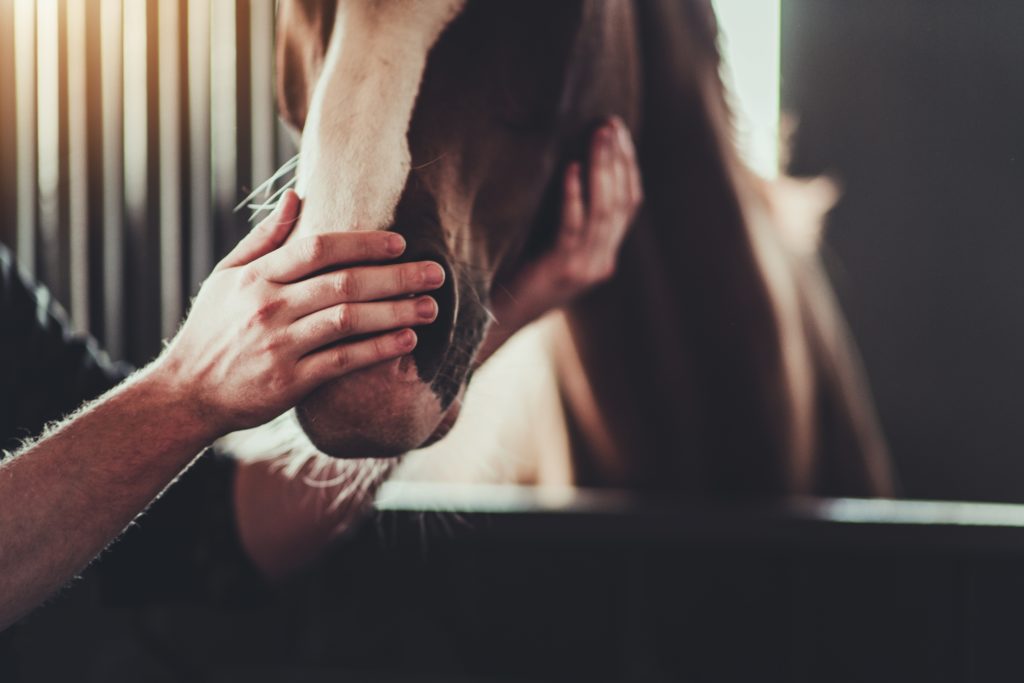
Next Module: Making Your Plan!
Now that you have completed your walkthrough of the barn/facility, we’re ready to start making a plan. Our next module will introduce the best practical management practices for fire prevention. Then, you will be able to create your fire prevention plan, and prioritize the management practices that can help reduce the risk to fire to your property.
Click the “Mark Complete” icon at the bottom of the page to move on to the next module!

Ready to go the extra mile for the horses in your care? Explore these extra resources!
Ontario Equestrian – Fire Safety on the Barn
Barn Fire Prevention video series – Government of Ontario
Heated Barns and Horses: Special Considerations – TheHorse.com
More at Stake than just the Barn Video: Perth East Fire Department
Handy Tip: Reach out to your local fire department/first responders, and inquire if they can come to your facility to perform a safety walkthrough. This will not cause a negative effect on your property insurance – they are there to help you!

References and Resources:
Content from this module was based upon by the short course Fire & Emergency Preparedness by Equine Guelph – cited below. All images are free use stock images from Unsplash and iStock. Top 3 Causes of Barn Fires graphic – self.
The content in this module was created with the sole purpose of submission to EDU2002 – Algonquin College, and should not be considered as an official source for fire prevention information.
The references listed here, coupled with the course developer’s experience, have been used in the development of this module:
Burke, B. (2022, June 6). Community members rallied to safely transport horses during Keene area barn fire. The Peterborough Examiner. Retrieved June 28, 2022, from https://www.thepeterboroughexaminer.com/news/peterborough-region/2022/06/06/community-members-rallied-to-safely-transport-horses-during-keene-area-barn-fire.html.
Raymond, S., Ecker, G., Self. (2022) Fire & Emergency Preparedness. Short Online Course. Equine Guelph. https://thehorseportal.ca/course/fire-emergency-preparedness-fall-22/
Finlay, D. (2019). Barn Fire Safety – Causes of Barn Fires – Troy Moffatt. YouTube. Equine Guelph. Retrieved June 28, 2022, from https://youtu.be/KQyUr7xh0YM.
Finlay, D. (2020). What are some of the biggest myths about barn fires? YouTube. Equine Guelph. Retrieved June 20, 2022, from https://youtu.be/otTzcpSGEmY.
Finlay, D. (2020). Will horses run back into a burning barn? Equine Guelph. Retrieved June 20, 2022, from https://youtu.be/7FhzOXgSULc
Fire safety on the farm – reducing the risk. Ontario Equestrian. (2014, June 6). Retrieved June 20, 2022, from https://ontarioequestrian.ca/fire-safety-on-the-farm-reducing-the-risk/
Gimenez (Husted), R. (2018, June 13). Dr. Rebecca Gimenez: Barn fire issues & mitigation. Best Horse Practices Summit. Retrieved June 27, 2022, from https://www.besthorsepracticessummit.org/dr-rebecca-gimenez-barn-fire-issues-mitigation/
Government of Ontario. (2021, February 12). Barn Fires – A Concern for Ontario Farmers. Ontario Ministry of Agriculture, Food, and Rural Affairs. Retrieved June 20, 2022, from http://omafra.gov.on.ca/english/engineer/facts/barn_fire.htm
Government of Ontario. (2019). Barn Fire Prevention – Electrical. YouTube. Retrieved June 20, 2022, from https://www.youtube.com/watch?v=nSyT6K7ea7s.
Jerrett, A. (2022, April 7). Firefighter injured, two horses killed in Nova Scotia barn fire. CTV News Atlantic. Retrieved June 28, 2022, from https://atlantic.ctvnews.ca/firefighter-injured-two-horses-killed-in-nova-scotia-barn-fire-1.5852520
National Farm Animal Care Council. (2022). Code of Practice for the Care and Handling of Equines. National Farm Animal Care Council. Retrieved June 20, 2022, from https://www.nfacc.ca/codes-of-practice/equine
Oklahoma State University. (2021, April 26). Heated barns and horses: Special considerations needed. The Horse. Retrieved June 28, 2022, from https://thehorse.com/120535/heated-barns-and-horses-special-considerations-needed/
Patton, Z. (2015). More at Stake than the Barn. YouTube. Perth East Fire Department. Retrieved June 20, 2022, from https://www.youtube.com/watch?v=wMB0QFvwKww.
Self (Ed.). (2018, July 10). Fire Safety Checklist – Equine Guelph. Equine Guelph: Helping Horses for Life. Retrieved June 20, 2022, from https://www.equineguelph.ca/pdf/infosheets/Fire%20Safety%20Checklist%20infosheet.pdf







